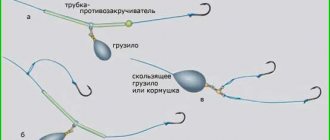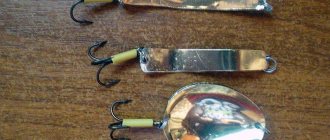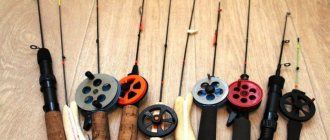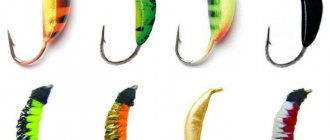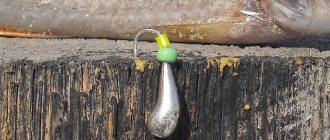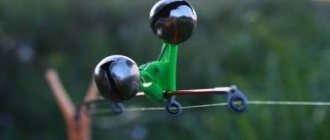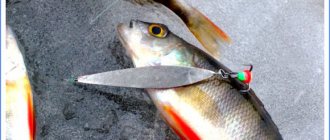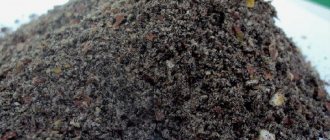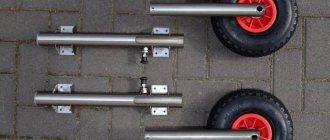Gear device
As mentioned earlier, donka - zakidushka is a classic version of donka.
Most fishermen pay attention to it for its affordability and simplicity. The gear structure is simplified as much as possible and consists of the following design:
- a reel or an ordinary wooden plank;
- sinker, on average 30-120 grams;
- braided or monofilament fishing line;
- hooks for carp, carp.
Important! Attention should be paid to the following fact. The fishing line must have a cross-section of more than 0.3 mm, otherwise, if at least a medium-sized carp is caught, the angler may cut his hands or completely lose his tackle, and with it the fish.
Installation of gear
Fishermen continue to improve their old fishing gear using new materials and tools. Let's look at how to make a zakidushka in the classic version.
Classic snack
It is difficult to imagine a simpler tackle than the classic donka.
- To make it, you need a monofilament fishing line (sometimes a nylon cord), the thickness of which depends on the type of fish. Monofilament 0.35-0.40 mm may be optimal.
Attention: using thin fishing line is dangerous because
When casting or retrieving large fish, you can cut your hands. The length of the fishing line is limited to 50 m; it is unlikely that you will be able to cast the rig further.
- A sinker or stone is tied to the end of the fishing line, the weight of which is determined by the nature of the reservoir and the casting distance. For still water, it is enough to tie a lead weight weighing 50 g, and when fishing in a strong current, anglers mount hammers weighing 100-200 g.
- Half a meter from the sinker, a leash is tied to the main line. It is made from a thin fishing line 0.20-0.30 mm, and in the case of pike fishing you cannot do without steel wire. The length of the leash is 0.3-0.5 m. The hook is selected taking into account the bait and the size of the intended trophy.
- It is most convenient to store the equipped zakidushka on a wooden or foam reel. An integral part of the gear is a bell, which is designed to signal a fish bite.
Photo 1. Original assembly of a skewer on a skewer with a reel.
Donka with sliding weight
Some shy fish species, such as bream, throw the hook with bait at the slightest resistance of the fishing line. A modernized hook with sliding equipment helped solve this problem.
- In one design, the olive sinker is mounted on the main fishing line. The distance of the weight to the hook is adjusted with a rubber stopper. Previously, instead of such a limiter, they wound a thread or attached a piece of sheet lead. A leash with a hook was mounted to the end of the base. When biting, the sinker remained at the bottom, the fish did not feel the catch and boldly swallowed the bait.
- Another version of the donkey with a movable sinker looked like this. The load was attached to the main line through a leash with a swivel. A rubber damper acted as a limiter. At the end of the tackle there was a leash with a hook. This method of equipment made it possible to raise the bait above the bottom surface. To do this, it was necessary to tighten the fishing line and fix the tackle in this position.
A modern version of a snack
Today, inexpensive short spinning rods are increasingly used for fishing for bait. Fishing rods made of fiberglass or aluminum are equipped with simple inertial reels or cheap “meat grinders”. Thanks to this modernization, the casting distance increases to 100 m. In addition to the reel, all other elements of the classic donkey (line, sinker, leash with hook, bell) are used in the equipment. This version of the zakidushka has become heavier and more cumbersome. But if you have a car, you can turn a blind eye to this drawback. But a donkey with a rod and reel allows the angler to quickly cast, change the fishing location, vary the distance and comfortably land fish.
Photo 2. Modern rigs with a rod and reel.
Advantages and disadvantages of donkey-tuck
The advantages of such gear. Casting for carp certainly has its advantages, which is why it is becoming popular among fishermen:
you can make long casts up to 150 meters from the shore;- even with a strong current, the equipment falls to the bottom and can remain there for the required amount of time;
- Due to the fact that the bait is located next to the hook with the bait, there is a high probability that the fish will definitely bite.
It is noteworthy that when fishing in this way, there is absolutely no need to constantly monitor the entire process. It is enough to hang a bell or any other signaling device and be nearby. This is incredibly convenient, because in fact, a bite can occur very rarely, up to once every few hours.
Flaws. Despite the fact that this method is considered quite catchy, it also has its negative aspects:
- The gear has absolutely no sensitivity. Changes can only be observed when the fish has already been spotted. Therefore, for lovers of a more dynamic type of fishing, this tackle is not suitable;
- there is practically no chance of catching a large fish, especially if it is a carp weighing more than 5 kg. The problem is that this is a fairly strong fish, so without a good rod and a spinning reel, most likely you won’t be able to catch the catch.
Equipping a hook and catching different fish
Depending on the fishing conditions and the type of fish you plan to catch, the equipment of the bait may vary. The only thing common to all equipment is the installation principles. Thus, the length of the fishing line is usually chosen to be 1.2–1.5 times the fishing distance. The weight of the sinker should provide the required casting distance and hold the equipment in place. When catching peaceful fish, the sinker is often replaced with a feeder. The leash should be 10–20% thinner than the main line. The hook size is selected according to the bait used.
Catching catfish with a hook
For fishing for catfish
As a rule, you make your own catfish bait. Its installation depends on the size of the catfish living in the reservoir. To catch small catfish up to 5 kg, use a main line of 0.5–0.8 mm, a leash with a diameter of 0.4–0.6 mm and a length of 0.5–0.6 m. The weight of the sinker is 50–70 g.
To catch large catfish, the fishing line is replaced with a strong cord (paracord or microcord can be used). The weight of the sinker is increased to 100–150 g. The use of the cord is explained not only by its strength, but also by the fact that fishing is carried out by hand without the participation of a rod and reel. Gloves can be used to protect your hands
When fishing for large catfish, it is very important not to wrap the fishing line (cord) around your hand. Tight line can cause serious injury
Bait for catfish can be:
- live bait;
- mole cricket;
- crawl out;
- frog.
In order to catch a catfish, a bait is thrown onto a riffle near a hole or under a steep bank.
How to make a bait for crucian carp
When fishing for crucian carp, use a fishing line of 0.3–0.4 mm and a leash of 0.18–0.25 mm. The length of the leash should be 10–20 cm, and the weight of the sinker or feeder should be 50–100 g. The following is usually used as a nozzle:
- worm;
- maggot;
Canned corn for catching crucian carp
- canned corn;
- pearl barley.
For carp fishing
The hook for catching carp is done in the same way as for crucian carp, but all the elements of the equipment are proportionally increased. When fishing for carp with a hook, you can use boilies and pellets on carp hair rigs.
Another option for equipping a bait for carp is to use a makushatnik. The sinker in it is a small lead plate measuring 3x5 cm. A piece of sunflower cake of the appropriate size is tied to it. Hooks on short (5–10 cm) leashes are tied to the holes in the sinker and stuck into the cake. Usually two or four hooks are used. For leashes it is better to use 0.15–0.20 mm braid. You can replace the braid with dark-colored nylon thread.
For catching bream
When catching bream with a cast, use a fishing line of 0.3–0.4 mm and leashes of 0.18–0.22 mm. The length of the leash is 20–40 cm. Since the bait for bream is most often used in the current, flat weights weighing up to 150 g are used.
The most commonly used attachments are:
- a bunch of worms or crawling;
- maggot;
Peas for catching bream
- peas;
- unsalted lard;
- mask.
Along with bream, you can often find silver bream, large roach, and ide.
Casting for pike
Predatory fish - pike, pike perch, perch, burbot - are most often caught using live bait. In this case, fishing lines of 0.3–0.6 mm are used. The length of the leash is 40–60 cm. To catch pike, you must use a metal leash; for other predatory fish it is not needed. The leash is attached to the main line through a swivel to avoid tangling the rig with live bait.
The weight of the sinker is 50–100 g, depending on the size of the live bait and the strength of the current. It is better not to use juveniles of valuable fish species as live bait.
Features of catch fishing
It’s worth noting right away that catch fishing can be done at any time of the year. The main condition is the absence of ice on the reservoir and the presence of fish in it.
To increase the efficiency of this type of gear, it is necessary to throw several pieces at once. With one bait, you can sit for a long time waiting for a bite and get a very modest catch all day. Professional fishermen throw 10 or more gear at the same time. In this way, it is possible to fish a promising place as efficiently as possible.
This type of gear will also be relevant when fishing in water areas with thickets or snags. This is due to the fact that it is almost impossible to lose equipment in such places. Among other things, with a casting rod it is comfortable to fish in the bushes, where it is not very convenient or extremely difficult to cast a float rod.
When recasting, immediately lay down the fishing line correctly on the shore. It is best to do this in circles so that later it does not get tangled and the angler does not waste time untangling it.
Fishing technique
A few words about the actual casting of the load. I clamp a wooden pin tied through a nylon cord to the weight of a fishing rubber band with the fingers of my right hand (the cord is passed between the fingers) and begin to swing the lead blank.
In the second or third period of the swing, an energetic swing follows in the direction chosen on the pond. In this case, the pin is released from the hand at the right moment and follows the elastic lines into the water.
After casting, the load can easily go into the water beyond the 60-meter mark. But this is at a good initial speed of departure of the lead blank.
However, you need training and, undoubtedly, skill for this work. That's all! Happy bottom fishing!
How to make a carp bait with your own hands?
Installation of the zakidushka is so simple that you can do it yourself:
It is enough to take no more than 50 meters of the main line. Most often they use braided cord or monofilament. This length will be enough, because if you take more, you won’t be able to cast far, especially without a reel and rod.- You will need to attach a sinker to one end. As for the shape, it is necessary to take as a basis the strength of the current, the features of the bottom and other fishing conditions.
- Next, you need to tie the leash to the main fishing line, approximately at a distance of 35 to 65 cm from the load. The leash should be a little thinner, for example with a cross-section of 0.2 mm. As for the length of the leash, the best option would be a length from 25 to 45 cm.
- We knit a hook.
Now the snack is ready. If you wish, you can tie another leash, but you need to understand that in this case, the risk of tangling the fishing line will sharply increase.
What is casting and fishing with it?
What is the design of the zakidushki? Everything is quite simple - this is a large-diameter fishing line, it is best to take up to 0.8-0.9 mm, on which a sinker and one or more hooks on a leash are attached. It is recommended to install a leash with hooks with a fishing line slightly thinner than the main one.
The remaining end of the fishing line must be wound on a special reel; the method of winding depends entirely on the casting method.
For catching crucian carp, a bait with an installed feeder is perfect.
For experienced and experienced fishermen who know how to properly tie a leash to the main line, you can also use special loops for leashes.
Choosing bait and bait
It is very important to choose the right baits, as they should not only match the taste preferences of carp and carp, but also sit tightly on the hook. You should immediately throw aside the pearl barley, dough, peas, mash and semolina. They will fly off at the casting stage. It is best to choose harder baits, such as:
cake;- boilie;
- maggot;
- pellets;
- worm;
- corn, etc.
Making a snack
To make a hook you will need fishing line, hooks, a sinker and a reel.
To talk about the reel is to test your patience. It could be an empty plastic bottle or a shape cut out of plywood. Any device that will hold the fishing line and not slide off on its own. The length of the fishing line is the length that you can cast by hand. Plus 3 meters for fixing on the shore and “as a last resort.”
The diameter of the main and leashes can be the same. This is 0.25 - 0.3. Or the main part is from 0.35 to 0.5, and the one on which the equipment is knitted is no thicker than 0.3.
You should not assume that crucian carp are so picky that they will be afraid of leashes of this diameter. What is important for float tackle fades into the background for crucian carp bait.
The main thing to take into account here is that the areas near the shore are the most dangerous in terms of snags. This means that the reliability of fastening the sinker and hooks is a priority.
Another important point is the location of the leashes in relation to the main line. If you tie it incorrectly, the leash with the hook will twist with the main one or lie next to it. And it is required that the baited hooks move to the sides.
How to catch with a hook?
Not every angler knows how to cast a bait correctly. There is no difficulty in this if you install it correctly.
First you need to choose the right place on the shore where you can drive in a holder or something to attach the gear.- Now you need to tie the tackle to the holder - a support or fix the reel. Moreover, the latter option will be even more convenient, since at any time you can tighten the fishing line by winding it on the reel. Be that as it may, the fishing line needs to be securely fixed.
- The next step is to unwind the tackle and lay the fishing line on the shore in circles of approximately 65 cm.
- It's time to set the bait.
- You need to take the fishing line in your hands, slightly above the load, and throw it into the water.
- Now you need to attach the sound alarm to the fishing line near the support.
Features of the tackle
Of course, you shouldn’t expect anything supernatural from the converted gear, but it will provide basic capabilities, allowing you to catch fish. A donka from a spinning rod will be inferior to a feeder or picker in sensitivity, range, and power. However, with it you can throw the equipment into the water, record the bite and pull out the prey.
How to assemble a donk correctly
Not every spinning rod can be used in bottom fishing. Naturally, nothing will come of UL “sticks” and light “rods”. But a rod designed for lures weighing over 20 grams will make a smart catch. In this case, the fishing rod must meet the following criteria:
- length from 2.40 to 3.00 meters;
- the lower limit of the dough is not lower than 20 grams;
- tuning is parabolic or medium.
For donkey it is better to take a slow action spinning rod
Fast “evil” spinning rods are not suitable for bottom fishing, despite their better sensitivity, since with such a tool it will not be possible to cast bottom equipment, which requires a smooth throw with acceleration.
Casting technique
It is very important to cast the bait using the pendulum method. Moreover, this is a rather responsible and important moment, so before you “fill” your hand, it is best that no one is nearby at this moment. You need to take the fishing line in your hand, approximately 1 meter from the load, and begin to unwind it. After sufficient speed has been achieved so that it has enough inertia to reach a certain area, the tackle is sent forward into the reservoir.
There is another, more advanced, but no less simple method. You need to take a stick with an approximate length of 65-75 cm. Put a weight on it and cast it into the desired area of the reservoir. You need to tie a loop to the weight that will be attached to the edge of the stick. Thanks to this, it is possible not only to throw the bait further, but also more accurately.
How the zakidushka is completed
The zakidushka tackle consists of several important elements.
Each element in the bundle plays its role.
Hook
You can find any hook on sale today. If so, then you should choose the most suitable one. Beginners will probably be confused, especially when they see that there are some numbers on the box. However, there is nothing complicated about it. You need to know that the main size is the width, which is how the product number is determined. By the way, domestic and foreign manufacturers may have the same hook with a different number, since there is a different classification.
fishing line
Fishing line is another element that the store has in abundance. The difference lies not only in diameter, as many believe, but also in material. It can be monofilament or braided cord. If you are doing the casting yourself, then you can pay attention to monofilament fishing line, with a cross-section of 0.2-0.6 mm. As for leashes, a diameter of 0.10-0.12 mm is quite sufficient.
Important! The parameters of the fishing line directly depend on the fish that the fisherman is going to hunt.
Sinker
The presented element can be bought in a store, then the weight of the part should be in the range of 100-150 grams, and found in your yard or right on the shore. In the second case we are talking about a stone, a piece of brick and the like. The main thing is to choose flat products so that they do not roll along the bottom.
Tips for fishing
Quite often they are caught by snookers at night, which is why you need to have a good flashlight with you. This is necessary for proper placement of maggots and other bait. The most convenient option is a cap flashlight, which is attached to the visor.
In specialized stores you can find hats that already have lanterns sewn into them. You can also use lamps on the shore, but they will have to be turned off constantly so that the carp is not afraid of bright lighting.
Before heading to a new body of water, it is advisable to learn as much as possible about it. To do this, it is important to communicate directly with those fishermen who permanently reside there. Moreover, these can be not only fishermen on the shore, but even sellers in stores, because often local residents near the reservoir spend their weekends fishing.
If the fisherman has already fished with a bait before, then fishing for carp or carp should not create difficulties. The only thing you need to remember when catching such strong fish is that everything should be as reliable as possible. All gear must be as strong as possible, each knot must be securely tied, without haste and unnecessary fuss. If the bait for carp and carp is as reliable as possible, you can be sure that it will not fail you at the most crucial moment.
It is clear that the zakidushka is the most budget-friendly and at the same time simple tackle, but most fishermen catch different and large fish quite effectively with it. If you approach this issue as responsibly as possible, assemble the tackle efficiently and tie all the knots, you can be sure of a good catch. Video on the topic:
The simplest and catchiest tackle for carp, carp, crucian carp. Zakidushka (donka) for carp.
10:05
Fishing for snacks. Cake (makukha) for carp and crucian carp. Zander. Fishing on a Suzuki dr-z 400 motorcycle
32:18
Bottle-tack for fishing with bottom tackle. Fishing. Fishing
15:07
narybalke
Lure
For more effective fishing, anglers use bait.
It is needed for bottom fishing. For this purpose, all bottom gear is equipped with feeders. This can be the most ordinary bait, but with a feeder, which also plays the role of a sinker. Otherwise, the tackle is no different from ordinary bottom tackle. If you have a sinker feeder, leashes with hooks can be attached in various ways: before the feeder, after the feeder, or to the feeder itself. The main thing is that during fishing, leashes with hooks do not cling to the feeder, especially when casting.
The composition of the bait depends on what kind of fish you plan to feed during the fishing process.
Bream
Like any other fish, it loves its bait, with its own aromas. The main composition of the mixture should include both small components and large ones, which can hold the fish at the fishing point for a long time. At the same time, you should not get too carried away with bait, so that the fish does not become satiated prematurely and does not leave the feeding area. For fishing on the river, we can recommend the following bait composition:
- 200 g makukha (sunflower cake);
- 100 g breadcrumbs;
- 200 g of sprouted peas;
- 200 g boiled oatmeal;
- 3 teaspoons ground coriander;
- clay.
The consistency of the bait should correspond to the fishing conditions. A lot depends on the presence of current. If there is a current, then the viscosity of the bait should be such that it is washed out within 5-10 minutes. This is if the water is warm and the fish are active, and if the water is cold (autumn), then the rate of leaching of the bait should be reduced. In other words, the bait should be more viscous.
You can add various flavors to the bait, both natural and artificial. As for natural flavors, there are no special problems, but with artificial ones, you need to be very careful. The slightest overdose can be harmful, and instead of luring the fish, it will scare them away.
Pike
According to generally accepted opinion, it is impossible to feed a pike, but it is not indifferent to the smell of blood. Many argue that if you add a little fresh blood and clay to the bait, it will certainly interest the predator.
Carp
There is no definite recipe for bait for catching carp, but everyone knows that they really love corn. Corn is prepared like this: first it is soaked in water for a couple of days, and then cooked over low heat for an hour or an hour and a half. During the cooking process, you can add 1 or 2 teaspoons of sugar or any other flavoring or flavor enhancer. It should be remembered that the colder the water, the greater the amount of flavoring required. To prevent the carp from quickly getting enough, sand or coastal soil is added to the bait. Once in the water, these components will create a kind of cloud that will definitely interest the fish.
Som
To attach catfish, as a rule, components of animal origin are used. It is better to use something that a person does not eat. Basically, these are chicken giblets or the remains of other poultry. The liver works well because it has a specific smell. Additional processing, such as smoking or frying, gives good results.
crucian carp
The taste preferences of crucian carp are ambiguous and depend on various factors, including weather conditions. When choosing bait, an important factor is the presence of other fish species in the pond. If you plan to catch pure crucian carp, then the bait should be prepared for crucian carp. In order not to attract smaller fish, you should prepare bait with a minimum amount of small fractions. If only crucian carp is found in the reservoir, then the task can be simplified and any number of small particles can be introduced into the bait, as they attract fish. Bait for crucian carp can consist of barley, corn, wheat, peas, from which various types of porridges are cooked. You can also add raw ingredients to cooked porridges, in the form of corn and wheat chaff, as well as flakes and breadcrumbs.
